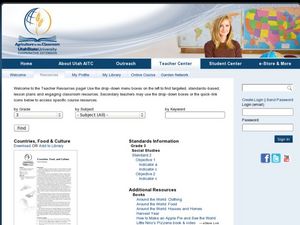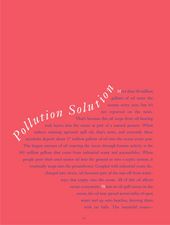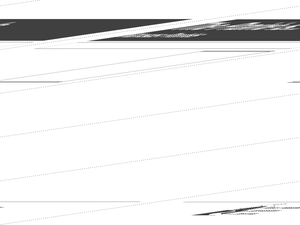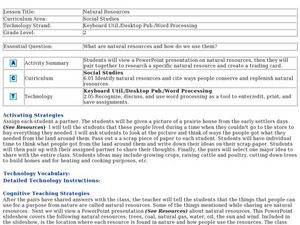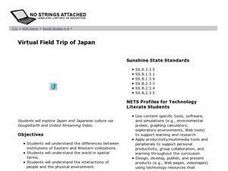Curated OER
Countries, Food and Culture
Third graders explore food production by researching culinary culture on the Internet. In this global food lesson, 3rd graders read assigned text about the different dietary habits of foreign cultures based upon their environment....
Curated OER
Sound
First graders investigate sound and recognize the importance of hearing. They listen to and identify sounds in the environment, classroom, and on a pre-recorded tape. The students classify each type of sound and participate in a Sound...
Curated OER
Wetland Adaptation
Fourth graders study the impact of the wetland environment on the migration of birds. They make a list of the important reasons on a large piece of paper to be posted in the classroom and point out the biggest wetland in the state (The...
Curated OER
Pollution Solution!
Learners listen to the story "Clean Air, Dirty Air" by Lynne Patchett and discover the main types of pollution and how these affect their bodies. In this pollution activity, students work in small groups to create a machine to prevent...
Curated OER
Teaching in a Time of Crisis
Young scholars react to the current financial crisis. In this community building lesson, students are given the opportunity to voice their thoughts and feelings on the current financial crisis in the safety of a classroom meeting.
Curated OER
The Prairie Is...
Learners investigate different environments by creating a poem. In this prairie environment lesson, students research information about Kansas' natural resources and complete a worksheet about prairies. Learners practice using poetic...
Curated OER
Community Explorations
Young scholars identify the strengths and weakness in their community. They take a community walk and take pictures of people interacting with the environment and the "green spaces" in their community. They then write a persuasive essay...
Curated OER
Animal Camouflage
Students investigate how animals adapt to their environment. In this animal science instructional activity, students participate in an experiment using patterned paper and plain paper to simulate how animals blend into their...
Curated OER
Natural Figures
First graders look for geometrical shapes in nature to help them appreciate the diversity of the natural environment.
Curated OER
Nebraska's Wild Weather
Students examine the weather in Nebraska. Using this information, they describe the cause and effect relationships in the environment based on these changes in weather. They write various types of poems with weather themes and share them...
Curated OER
Layout of preschool
Students examine instruction on the basics of layout of a preschool. They identify appropriate environmental space arrangement and arrange a preschool with centers, easy traffic flow and a workable environment. They study guidelines...
Curated OER
Natural Resources
Fifth graders begin the lesson by identifying the different types of natural resources. As a class, they discuss how environments are destructed and how the loss of one natural resource can affect the economy. Using a map, they label the...
Curated OER
Twisted Vision
Pupils investigate the vision adaptations in marine animals in their environments. In this life science lesson, students use polarized filters and make observations. Pupils explain how the adaptation of polarized vision is an advantage...
Curated OER
Microbe Multiplication Magic
Learners discover how microbes multiply. In this infectious disease activity, students calculate the growth of bacteria in various environments. Learners determine the role that the environment plays in the spread of infectious disease.
Curated OER
Biomes: Adapting To Deserts & Other Ecosystems
Middle schoolers examine how animals must be adapted to the conditions of its environment to survive. In this biomes lesson students research desert adaptations then discuss how these animals have survived.
Curated OER
Utah's Own
Fourth graders examine the effects of humans on the environment. In this Social Studies activity, 4th graders analyze human changes to the environment. Students explore the actions and effects at a community level.
Curated OER
Wetland Adaptation
Students participate in a simulation to investigate the impact of the wetland environment on the migration of birds. They discuss the patterns of migration they took and why they avoided certain wetlands.
Curated OER
Pollution Solutions
Young scholars visit a local park to test the quality of the aquatic environments. They search for sources of pollution and examples of pollution control. Based on their obeservations and experiments, they rate their local environment.
Curated OER
Virtual Field Trip of Japan
Students explore Japan and Japanese culture via GoogleEarth and United Streaming Video. This lesson plan is intended for a middle-level social studies class and includes a wonderful lesson plan extension idea and a video explaining...
Curated OER
Prairies
Students identify the basic characteristics of the prairie ecosystem, and several commonly known prairie species. They create a classroom mural of a prairie ecosystem; and create reports about what they have found out.
Curated OER
Forest Floor Terrarium
Students study the aspects of a forest floor ecosystem, including decomposition, the water cycle, food webs, the needs of living things, and physical vs. chemical change over an extended period. In addition, students conduct observations...
Curated OER
How Does It Feel?
Students identify the textures of materials in their environments in order to expand their language, math, sensory, and observational skills. In this sensory activity lesson, students first write a list of different words to describe...
Curated OER
Primary Geometry
Students identity simple geometric shapes. In this early geometry lesson, the teacher introduces students to triangles, squares, and rectangles, then students identify and classify the shapes as they are found in the classroom. To...
Curated OER
Learning from the Video Clips
Students view a wilderness video and write to explain the purpose of the video. In this wilderness video lesson, recognize how physical and living parts of the environment interact. Students understand how an ecosystem works.


